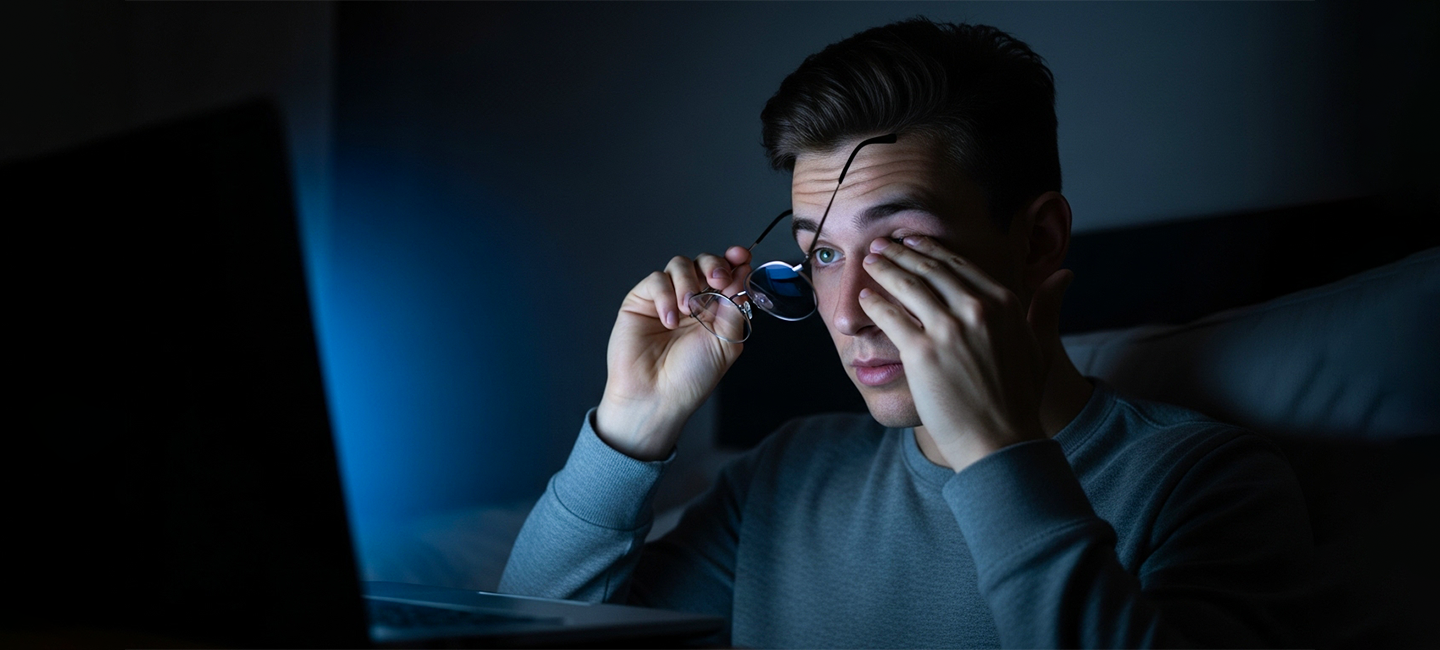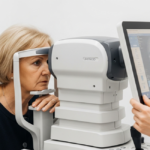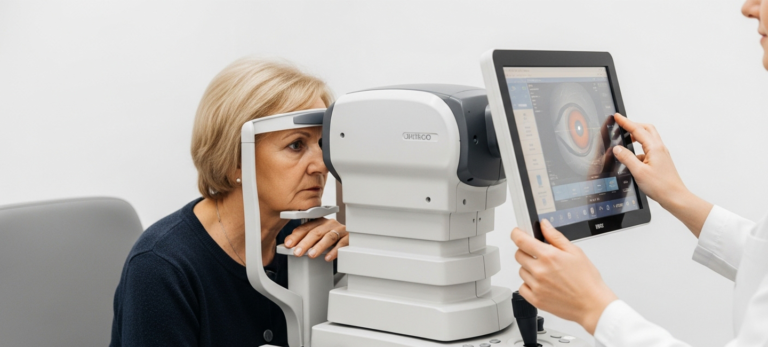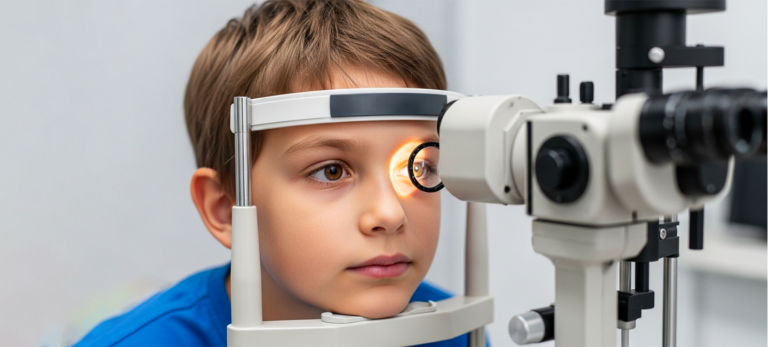Our Eyes vs. the Digital Era In today’s always-connected lifestyle, Americans spend an average of 7 hours and 4 minutes per day looking at screens — phones, computers, TVs, and tablets combined (DataReportal, 2025). That constant exposure means our eyes are under more pressure than ever before. At My Eye Care, we’ve seen firsthand how …
Our Eyes vs. the Digital Era
In today’s always-connected lifestyle, Americans spend an average of 7 hours and 4 minutes per day looking at screens — phones, computers, TVs, and tablets combined (DataReportal, 2025). That constant exposure means our eyes are under more pressure than ever before.
At My Eye Care, we’ve seen firsthand how “digital eye strain” — also called computer vision syndrome (CVS) — is becoming one of the most common vision complaints in both adults and children. Thankfully, with the right knowledge, technology, and expert guidance, there are ways to protect your vision while living in a digital world.
What Is Digital Eye Strain?
Digital eye strain (DES) refers to a group of vision and comfort issues caused by prolonged screen use. It’s not a single disease — it’s a collection of symptoms that result from how digital devices affect our eyes and visual habits.
Common Symptoms Include:
- Blurred or double vision
- Eye fatigue or discomfort
- Headaches
- Dry or watery eyes
- Neck, shoulder, or back pain
According to the American Optometric Association (AOA), over 50% of computer users experience digital eye strain daily (AOA.org, 2024).
Source:
Why Screens Cause Eye Strain
Several factors contribute to digital eye strain:
- Reduced Blinking Rate:
When staring at screens, blink rates drop by nearly 60%, from 15–20 blinks per minute to as few as 5–7 (National Eye Institute). This leads to dryness and irritation. - Blue Light Exposure:
LED screens emit high-energy blue light (400–490 nm). Over time, prolonged exposure can disrupt circadian rhythms and may contribute to retinal stress. - Poor Ergonomics:
Viewing screens too close, at the wrong height, or in poorly lit environments can increase strain on both eyes and neck muscles. - Uncorrected Vision Problems:
Even mild nearsightedness, farsightedness, or astigmatism can worsen strain if untreated — especially during prolonged digital use.
Source:
The Science of Blue Light
Blue light isn’t inherently bad — it helps regulate our sleep-wake cycles and boosts alertness. But excessive artificial blue light, especially at night, interferes with melatonin production and may accelerate digital eye fatigue.
Recent studies show:
- 90% of adults use a screen within one hour of bedtime.
- Nighttime blue light exposure suppresses melatonin by up to 23%, disrupting sleep quality.
(Harvard Health, 2024)
- Laboratory studies also indicate that blue light can induce oxidative stress in retinal cells, though long-term human impact studies are ongoing (NIH PubMed, 2023).
Source:
How to Prevent and Manage Digital Eye Strain
1. Follow the 20-20-20 Rule
Every 20 minutes, look at something 20 feet away for 20 seconds. This simple break gives your eyes a chance to relax and refocus.
2. Blink More, Consciously
Use reminders or apps to help re-train your blink reflex. Artificial tears or lubricating drops can also help reduce dryness.
3. Adjust Screen Setup
- Keep screens 20–28 inches from your face.
- The screen top should be slightly below eye level.
- Reduce glare by adjusting brightness and using matte filters.
4. Consider Blue-Light-Blocking Glasses or Filters
Clinical studies show mixed results, but many patients report less eye fatigue and improved comfort using blue-light filters, particularly for nighttime screen work (Ophthalmic & Physiological Optics, 2023).
5. Regular Eye Exams
A professional eye exam can detect underlying refractive errors or focusing problems that contribute to strain. At My Eye Care, we use digital refraction and smart imaging to ensure your prescription and screen setup are optimal for your lifestyle.
Source:
Ophthalmic & Physiological Optics
The Hidden Cost of Screen Time for Kids
Children are especially vulnerable.
A 2024 report by the American Academy of Ophthalmology (AAO) found that screen time among children tripled since 2015, and cases of myopia (nearsightedness) have risen by 26% in the same period.
Too much close-up work can affect eye development, leading to early-onset myopia.
At My Eye Care, our pediatric eye care and myopia control programs (including Ortho-K and MiSight) help protect young eyes with proactive monitoring and non-invasive treatments.
Blue Light and Sleep Quality
Your eyes and brain are connected — quite literally.
Blue light from phones and laptops can trick your brain into thinking it’s daytime, leading to insomnia and fatigue.
A Harvard study showed that people using screens 2 hours before bedtime took twice as long to fall asleep and experienced 55% less melatonin production than those reading printed materials.
Using night mode, blue-light filters, or digital wellness apps can significantly improve rest and reduce fatigue-related eye symptoms.
The My Eye Care Approach
Our mission is to combine compassionate care with cutting-edge science.
When you visit My Eye Care, we:
- Conduct a comprehensive digital eye exam to assess your screen habits.
- Measure tear-film stability and blink rate to evaluate dryness.
- Provide tailored solutions like blue-light protection lenses, ergonomic advice, and dry-eye therapy.
- Offer CareCredit financing and walk-in access to make your care stress-free and affordable.
We go beyond prescriptions — we protect vision for life.
Key Statistics to Remember
- Average screen time (U.S., 2025): 7.04 hours/day
- Percentage of adults reporting digital eye strain: 68%
- Blink rate reduction during screen use: ~60%
- Adults who use screens 2 hrs before bed: 90%
- Global prevalence of myopia (projected 2050): 50% of the population
Conclusion: Give Your Eyes the Break They Deserve
Technology is here to stay — but that doesn’t mean your eyes should suffer for it.
By following smart screen habits, using the right eyewear, and scheduling regular eye exams, you can protect your vision for years to come.
At My Eye Care, we help patients find the perfect balance between modern life and lifelong eye health.
Ready for relief? Book your digital eye health check today.
Read more about:
Frequently Asked Questions:
1. What causes digital eye strain?
Digital eye strain is caused by prolonged screen use, reduced blinking, poor lighting, and uncorrected vision problems. It leads to fatigue, dryness, and blurred vision.
2. How long does digital eye strain last?
Symptoms typically resolve after resting your eyes for a few hours. Chronic strain, however, can persist if poor screen habits or underlying eye conditions are not corrected.
3. Does blue light cause permanent eye damage?
Current research shows no conclusive evidence that blue light from screens causes permanent retinal damage, but it does cause temporary discomfort and sleep disruption.
Source:
4. Do blue-light-blocking glasses work?
Several studies (e.g., Ophthalmic & Physiological Optics, 2023) show blue-light filters can reduce eye strain and improve comfort, especially in low-light or nighttime screen use.
5. How can I relieve eye strain naturally?
Use the 20-20-20 rule, blink often, stay hydrated, and ensure proper screen distance. Warm compresses and artificial tears can soothe dry, tired eyes.
6. How much screen time is too much for children?
Experts recommend limiting recreational screen time to no more than 2 hours per day for children over 5, and avoiding screens altogether for those under 2.
Source:
American Academy of Pediatrics
7. Can dry eye be caused by computer use?
Yes. Prolonged screen time reduces blinking and tear production, leading to evaporative dry eye syndrome. Digital users are up to 3× more likely to develop dry-eye symptoms.
8. Is digital eye strain reversible?
Absolutely. Adjusting ergonomics, using proper eyewear, and maintaining regular eye exams can fully reverse symptoms and prevent recurrence.
9. Does screen brightness affect eye strain?
Yes. High brightness and glare increase eye fatigue. Set your screen brightness to match ambient light levels and avoid reflections for optimal comfort.
10. How can My Eye Care help with digital eye strain?
We provide customized digital vision assessments, blue-light-filter lenses, and dry-eye therapy. Our team uses advanced technology and compassionate care to restore comfort and clarity.




